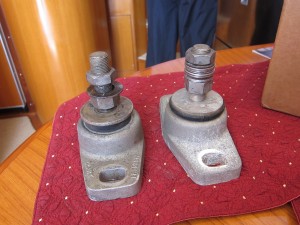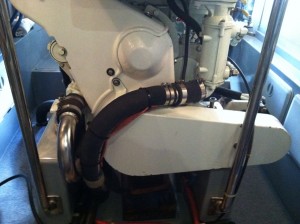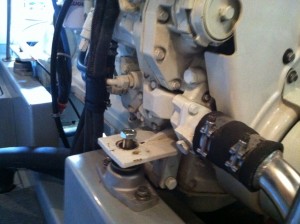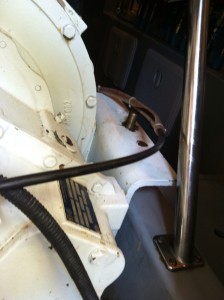Last April (2011), we took Kosmos into a local boat yard, Driscoll, to have some work done. The two rear engine mounts had worn out, causing some vibration, the main house alternator was nearing the end of its life, and the a through-hull needed a new barb. Driscoll was supposed to replace the two back engine mounts, rebuild the alternator, and fix the through-hull. The work took two days. Christi was onboard all day both days, holed up in the pilot house working on The Unexpected Circumnavigation Part 2. Since the mechanics went in and out of the engine room through the hatch in the living room, they usually didn’t see her. But she heard them come and go, and heard every noise they made in the engine room, including their conversations. She noted exactly how many workers there were and how long they worked for. The labor hours totalled 11.
When the work was completed, Eric inspected it. The mechanics had forgotten to tighten one of the bolts on the engine mounts! And the alternator was not the same one they had taken to rebuild! The mechanics immediately tightened the bolt as Eric requested and apologized for the oversight, but both argued with Eric about the alternator, insisting it was indeed ours. For a good fifteen minutes, they swore up and down that the reason it looked different was as a result of the rebuild process — the guys that did the rebuilds were so good that they could make our American made Leece-Neville look like a brand new no name brand that was made in Mexico. Of course, they had no explanation for the fact that the alternator they removed was 140 amps and the one they installed was 160 amps.
Eventually, a supervisor came to deal with us. He said “Yes, that is a new alternator. Your old one was corroded inside and could not be rebuilt. You should be thrilled to have a new one instead of a rebuilt one. Why are you complaining?” When we told him we were sensitive to brand and wanted another Leece-Neville, not a generic no name brand, he said “What do you care what brand it is? Alternators are all the same.” We had to argue with him for a long time before we got to talk to a head honcho. The head honcho reluctantly agreed to swap out the alternator they had installed for a Leece-Neville, with no extra labor charge to us since it was their error for installing something without asking our permission first. As an FYI, Leece-Neville had discontinued the 140 amp alternator, and we wound up with a 160 amp Leece-Neville. It did cost a bit more, but we think it will be worth it in the long run.
When the bill came, we were charged with 23.4 labor hours, not the 11 they had worked. When Christi went to talk to them about it, they said “How would you know what we worked?” When she said she was onboard the whole time, they were shocked. Clearly, it never occurred to them that they were being monitored.
At first, they insisted the hours were correct, but after some arguing, they finally lowered the bill to 16.53 hours. We knew some work was done off the boat, but we think it was probably an hour or less, not 5+ hours. But at that point we were tired of arguing and paid the 16.53 hours. We told the boss we were going to complain to “Lugger” Bob Senter and the boss immediately called Bob to tell him we were difficult people that didn’t know what we were talking about. Fortunately, Bob knew better.
Driscoll’s did eventually apologize for our unpleasant experience. They said the “billing error” was a “clerical mistake” and that the alternator shop they sub-contract to took it upon themselves to swap out the alternator without informing the yard, so the mechanics were under the impression that it was our alternator when they argued with us. While that may be true, we still think it was strange for them to argue with us instead of checking, and that they should not have argued with us at all about wanting a Leece-Neville as our replacement.
When we got back to the marina, we complained to three of our neighbors about the horrible experience with Driscoll. They all said that they weren’t surprised. Between the three of them, they recounted eight different horror stories that personal friends of theirs went through with Driscoll. Compared to some of the other stories, we got off lucky.
After the engine mounts were replaced, there was less engine vibration, but the vibration wasn’t gone. This August (2012), we took Kosmos into Shelter Island Boat Yard to have the bottom repainted. While there, a mechanic from JW Marine took a peek at the engine and confirmed what we suspected: the engine had not been properly balanced on the mounts. Sigh. The mechanic showed Eric that the majority of the weight was only on two of the four mounts, which was the likely cause of the vibration.
In October (2012), we finally had the mechanic come aboard to rebalance the engine. He disconnected the shaft from the engine and used a hydraulic jack to lift the engine.
The original plan was to simply lift it up and put it back down, making sure it was evenly balanced on all four mounts, then line up the shaft. But upon inspection, one of the mounts carrying the majority of the weight (a front mount) was broken. The bolt on the bottom of the mount was tightened down too low, which caused the metal bolt to detach. Also, the bolt was resting so low that it was probably actually the cause of the vibration. Here is a photo of the two mounts. The one on the right is the broken one. Note the seriously different heights of the two mounts due to the damaged rubber on the broken one. No wonder the engine wasn’t balanced!
We ordered two new mounts for the front. When they arrived, the mechanic changed out the old ones. Before he actually put the engine back down, he disconnected the exhaust from the engine in order to ensure that he had plenty of “wriggle room” to get the engine in exactly the right spot. He lowered it down, making sure that the weight was evenly distributed between the four mounts and that the shaft was perfectly lined up with the engine.
But he didn’t actually bolt it all back together. Instead, he said the engine needed to “settle” on the mounts for a few days — meaning let the weight of the engine squish down the rubber in the mounts — to make sure that, once completely settled, the shaft was still lined up within acceptable tolerance (under 5/1000th of an inch) of the engine. Here are some photos of the engine in the “settling” stage.
He came by the next day to measure the settling. Fortunately, while it had settled 2/1000th of an inch, it was still less than 5/1000. If the engine had shifted more and the shaft was no longer lined up, he would have had to re-balance the engine all over again. He came back three days later and measured again. It had not settled any further, so he was confident it was fully settled and ready to be put back together. Reconnecting the shaft and exhaust and bolting the engine in didn’t take very long.
We’ve taken Kosmos out a few time since then, in both the bay and to the ocean. We’ve only been out about three hours each time, but so far, the vibration seems to be mostly gone.






good good good vibrations